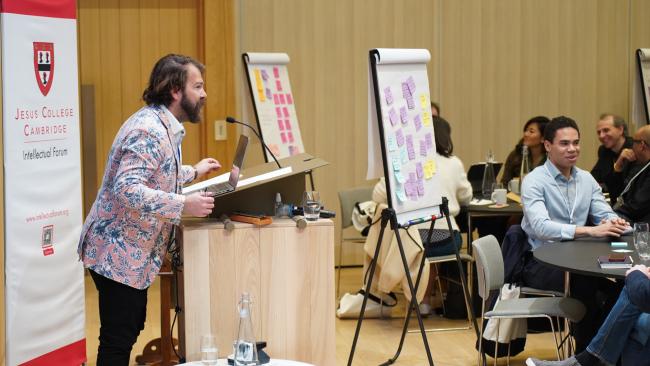
Digital productivity and wellbeing: top tips from Tyler Shores
In today's digital world, it's easy to get distracted and lose focus of what we need to do and what will keep us healthy.
The Internet is full of distractions, and it's hard to resist the temptation to check your email, social media, or news websites. But there are ways to avoid digital distractions and stay productive and mindful.
Here are some top tips from Tyler Shores, an Intellectual Forum Research Associate and creator of Jesus College's edX course Digital Wellbeing and Productivity.
Distractions notepad
One effective way to avoid digital distractions is to keep a distractions notepad in front of you. Whenever you feel the urge to check social media or any other website, write down what you wanted to check in the notepad. This way, you can go back to these distractions later and decide if they're worth your time. Often, you'll find that you're not that interested in them after a few hours.
Distractions budget
Another way to avoid digital distractions is to give yourself a distractions budget. Set aside specific times of the day when you can check your social media, news websites, or emails. Stick to this schedule and avoid checking them outside of these times. This way, you can still enjoy these distractions, but they won't consume your entire day.
Contain doomscrolling
Doomscrolling is the act of scrolling through your social media feed or news websites, looking for bad news or negative stories. To avoid doomscrolling, it's best to contain it to specific times of the day. Treat the news like it used to work, where it was only accessible during certain times of the day.
In terms of interstitial moments (in-between times when you're waiting for coffee or have some downtime), you could check the news if you're intentional about it, but if the news is going to stress you out or pull you in a different direction, do something else. Counterintuitively, I would say take a social media break rather than doom-scrolling if it's just a quick, novelty distraction that you want.
Escape the productivity trap
The productivity trap is the feeling that you should always be doing something productive, and it's a very easy trap to fall into. But it's essential to remember that work and life are marathons, not sprints. It's okay to take breaks and have valleys between peaks of productivity.
To escape the productivity trap, make a realistic set of tasks and goals. Break big projects into smaller, more manageable tasks, and prioritize what needs to be done first.
Schedule offline time
To avoid being online all the time, schedule offline time just like you would schedule anything else. Plan for some outdoor time, even if it's just a 15-minute walk in the park. Research shows that spending time in nature is good for our well-being. Prioritizing and scheduling your non-screen time will help you remember to take a break and recharge.
Procrastination
Procrastination is a common issue when it comes to digital distractions. One way to combat procrastination is to break tasks down into smaller steps. This makes it easier to start and keep momentum. Another way is to use a timer or the Pomodoro Technique. This involves setting a timer for 25 minutes and working on a task without any distractions during that time. After the timer goes off, take a five-minute break and then start another 25-minute work period.
In conclusion...
Digital distractions are everywhere, and it's hard to avoid them completely. However, by using the tips discussed above, you can reduce their impact on your life and stay productive and mindful online. Remember to be intentional about your distractions, take breaks, and prioritize your time. With practice, you'll find that you're more productive, more mindful, and less distracted.
To hear more from Tyler about how to maintain your digital well-being and productivity, check out Jesus College's edX course Digital Wellbeing and Productivity.





